LG Optimus G Performance Preview
by Brian Klug & Anand Lal Shimpi on September 18, 2012 1:17 AM EST- Posted in
- Smartphones
- LG
- Mobile
- LG Optimus G
Earlier tonight LG announced its Optimus G, the company's first Qualcomm Fusion 3 based smartphone (APQ8064 + MDM9615). If you don't follow Qualcomm's naming system closely, we're talking about a quad-core 28nm Krait SoC with Adreno 320 graphics core paired with its very popular 28nm LTE baseband. The CPU cores can independently clock up to 1.5GHz and users can even manually shut off a pair of cores to save power.
Brian got some hands on time with the Optimus G earlier tonight, but that just extended into a benchmarking session. While Brian spends more time with the Optimus G, he did send over a bunch of preliminary performance results from the device. We've seen APQ8064 in Qualcomm's MDP/T reference tablet, but this is the first time we've been able to gauge performance in a (nearly) shipping device.
I'm still not pleased with the current state of Android benchmarking but we'll have to make do with what we've got.
First off is Linpack, a reasonable indicator of heavy FP performance and memory bandwidth, but an even better tool for showing single and multi-core scaling.
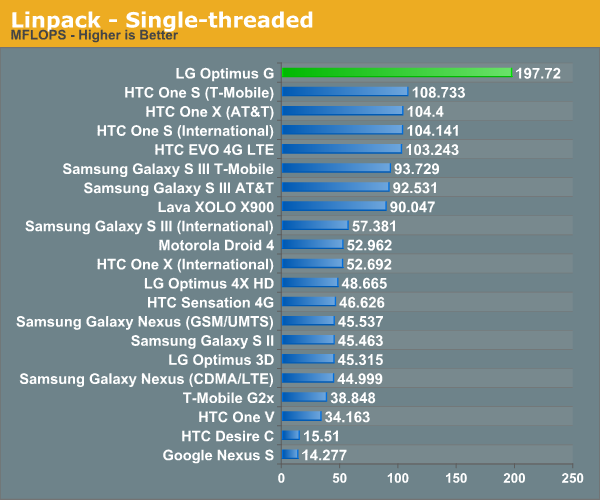
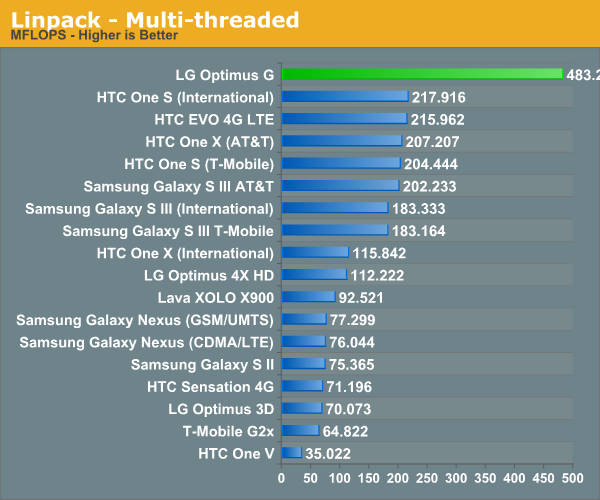
Qualcomm's Krait architecture has always done very well in this test, but the move to four cores doesn't actually show perfect scaling here. It's unclear if the test is simply running too quickly to produce a consistently high result, or if we're just running into issues feeding all four cores running at 1.5GHz because the 1 to 4 thread scaling is only around 2.45x here (vs 4x ideal). Either way we do see scaling beyond what you get from two cores with the quad-core APQ8064.
Next up we have our two standard browser benchmarks: Sunspider and Browsermark. These two tests use LG's custom browser and measure aspects of JS performance:
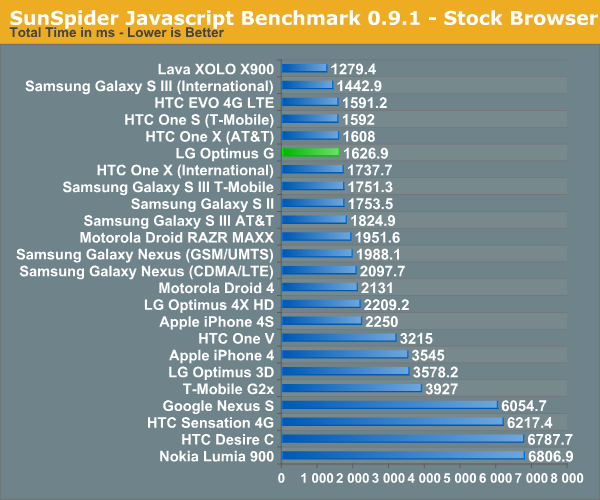
Sunspider is lightly threaded and thus doesn't see huge scaling going to four cores. In fact, in this case we're not seeing any real improvement over the dual-core Krait based devices from HTC. It's unclear how much of the Optimus G's performance is due to LG's browser/software stack vs. the underlying hardware.
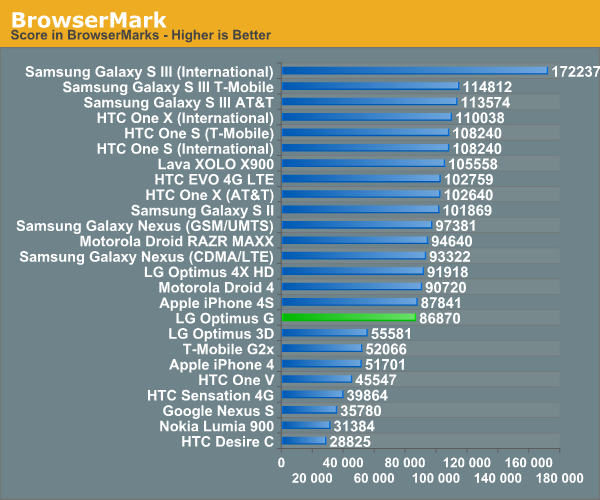
BrowserMark doesn't look great and the Optimus G's performance is almost certainly due to LG's own browser code. Qualcomm's reference software stack can provide great performance, but it's up to the individual OEM to take advantage of it.
Finally we have our two GLBenchmark 2.5 GPU tests: Egypt Classic and HD, both run in their offscreen 1080p modes without Vsync enabled. Here the Adreno 320 is really able to shine:
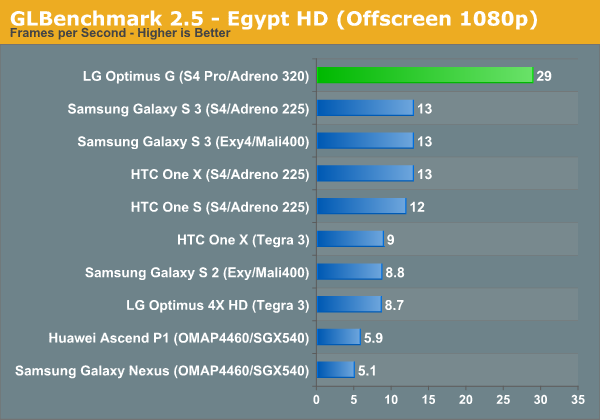
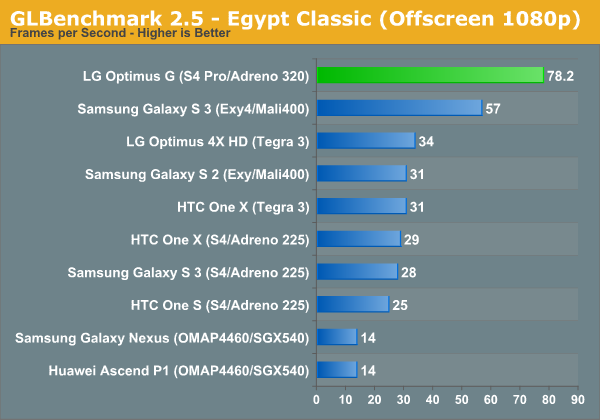
Performance looks awesome in both tests. The Egypt HD numbers are bordering on reasonably smooth and the classic numbers are great of course. Both of these tests run at resolutions higher than the Optimus G's native 1280 x 768 panel. At native res you're looking at 37.5 fps for Egypt HD and 59.8 fps for Egypt Classic, both extremely smooth.
If anything it's the GPU performance that's most exciting about the Optimus G. Most Android applications don't show great scaling from two to four cores, but the boost you get from the Adreno 320 will definitely be apparent in visually demanding games.
















20 Comments
View All Comments
phatboye - Tuesday, September 18, 2012 - link
On paper the hardware for this phone looks great. I would consider this phone as my next upgrade unfortunately LG does not have a reputation updating it's software very often. I really hope LG does not lock this phone down and allows the modding community to provide updates to the android stack.french toast - Tuesday, September 18, 2012 - link
Impressive phone, just a shame about lgs crappy software, the sunspider scores should be record breaking, as should browsermark and velamo...I'm pretty sure this beastie carries a 2mb slab of l2 cache....what effect that would have on performance who knows?Certainly hands on videos ICS looks gun shot fast...faster than my galaxy s3 that's for sure,
1008anan - Tuesday, September 18, 2012 - link
First off, excellent spec sheet. Although some of the specs seem to good to be true.How does the Adreno 320 compare with rogue PowerVR 6 skews? Could Anandtech do an article on the Adreno 320 compared with other low TDP integrated graphics?
It will be very interesting to compare LG Optimus G specs with the iphone 5 (notice it isn't spelled "i-phone") and OMAP 5 based phones. OMAP 5 might have an advantage in battery life because on lower power mode the two A15 Cortex cores sleep, leaving computational activity to the two Cortex M4 cores.
1008anan - Tuesday, September 18, 2012 - link
Is there any way the fab Samsung could steel any A6 tech from Apple? I know this is off topic; and sorry if that offends anyone.UpSpin - Tuesday, September 18, 2012 - link
The A6, if Anand is correct, is an ARM Cortex A9 with added functionality taken from the ARM A15 design.The Exynos 5 uses two vanilla A15 cores, mixed with two A7 cores and combined as big.LITTLE configuration with ARM Mali GPUs. It's a typical ARM design. As long as Samsung doesn't design their own cores like Qualcomm did with Snapdragon and Krait, and now probably Apple also did, they can't steel anything important from Apple.
toyotabedzrock - Tuesday, September 18, 2012 - link
I think Samsung did use a tweaked A9 licensed from a company Apple later acquired.The other phone manufacturers need to get better gpus asap adreno 320 will still be half as fast as the iphone5 if it doubled its performance. I do not understand why they ignore this part of their Soc designs.
Aenean144 - Tuesday, September 18, 2012 - link
Intrinsity was the company that did the circuit design for clocked the Cortex-A8 to 1 GHz in the Apple A4 SoC.Aenean144 - Tuesday, September 18, 2012 - link
Anand said the Apple A6 CPU is a custom ARM core, not a tweaked A9 nor a tweaked A15.mytexel - Tuesday, September 18, 2012 - link
Would be nice to compare to iPhone 5....powerarmour - Tuesday, September 18, 2012 - link
Not a bad phone at all, but bear in mind LG's 'support' or lack thereof...Jellybean?, nah... we won't bother with that